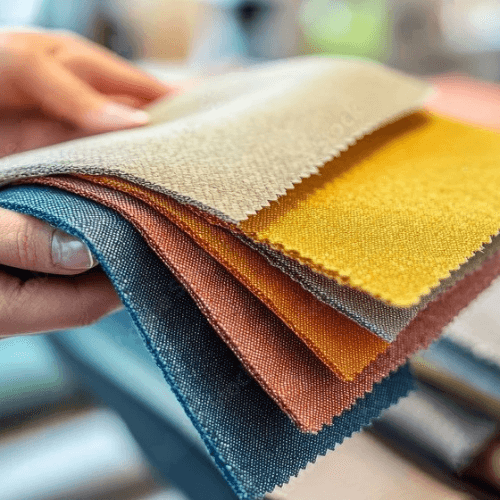Exploring the Latest Fabric Trends: What Buyers Are Looking For in 2025

As we step into 2025, the textile industry is witnessing a dynamic shift in fabric trends driven by changing consumer preferences, technological advancements, and a growing emphasis on sustainability. Buyers are increasingly seeking fabrics that not only meet their functional needs but also align with their values and lifestyle choices. This blog explores the latest fabric trends that are shaping the market in 2025 and what buyers are specifically looking for.
1. Sustainable and Eco-Friendly Fabrics
Sustainability continues to be a dominant theme in the textile industry. As consumers become more environmentally conscious, they are actively seeking out fabrics that minimize environmental impact. Key sustainable options include:
– Organic Cotton:Grown without harmful pesticides or fertilizers, organic cotton is favored for its environmental benefits and softness.
– Recycled Materials:Fabrics made from recycled polyester or other materials help reduce waste and conserve resources. These options are particularly appealing to eco-conscious consumers.
– Biodegradable Fabrics:Materials that break down naturally at the end of their life cycle, such as Tencel or hemp, are gaining traction as buyers look for sustainable solutions.
According to recent reports, demand for eco-friendly fabrics is expected to rise significantly as brands emphasize their commitment to sustainability in their marketing strategies.
2. Smart Textiles
The integration of technology into textiles is revolutionizing the industry. Smart textiles offer innovative features that enhance functionality and user experience:
– Temperature Regulation:Fabrics that can adapt to temperature changes provide comfort in varying climates, making them ideal for activewear and outdoor apparel.
– Moisture-Wicking Properties:Textiles designed to wick moisture away from the body are increasingly popular in sportswear, catering to consumers who prioritize performance.
– Health Monitoring Capabilities:Some smart fabrics can track biometric data, appealing to fitness enthusiasts looking for advanced wearables.
The demand for smart textiles is expected to grow as consumers seek products that combine fashion with functionality.
3. Natural and Textured Fabrics
As part of the broader trend towards sustainability, natural fibers are making a comeback. Buyers are gravitating towards fabrics that offer both aesthetic appeal and environmental benefits:
– Linen and Hemp:Known for their durability and breathability, these natural fibers are perfect for warm weather clothing and home textiles.
– **Textured Finishes:** Fabrics with unique textures—such as crinkled or slubbed finishes—are gaining popularity as they add depth and interest to garments.
Natural fabrics not only cater to consumer preferences for sustainability but also enhance the tactile experience of fashion[2][4].
4. Performance Fabrics
With an increasing focus on health and fitness, performance fabrics remain a key trend in 2024. These materials are engineered to support active lifestyles:
– Moisture Management:Fabrics designed to keep wearers dry during physical activities are essential for sportswear collections.
– Stretch-ability: Stretchy materials like spandex provide comfort and freedom of movement, making them popular in both active-wear and casual clothing.
5. Color and Pattern Trends
Color palettes and patterns play a significant role in influencing buyer decisions. In 2024, we can expect:
– Earthy Tones:Colors inspired by nature—such as browns, greens, and muted pastels—are set to dominate as they resonate with consumers’ desire for connection to the environment.
– Vintage Prints:Nostalgic patterns from previous decades are making a resurgence, appealing to buyers looking for unique styles that evoke memories while being modernized for contemporary fashion.
– Digital Patterns:As technology advances, digital prints featuring bold graphics or abstract designs are becoming increasingly popular among younger consumers.
6. Luxury Fabrics Making a Comeback
In contrast to the focus on sustainability, luxury fabrics like silk, velvet, and brocade are also seeing renewed interest:
– Silk: Known for its elegance and versatility, silk is being reimagined in contemporary designs that blend luxury with modern aesthetics.
– Velvet:This plush fabric adds texture and richness to garments, making it a favorite choice for evening wear.
As buyers seek a balance between comfort and sophistication, luxury fabrics offer an appealing option for special occasions[2][5].
### Conclusion
As we navigate through 2025, understanding fabric trends is crucial for textile businesses aiming to meet evolving consumer demands. The emphasis on sustainability, technological innovation, natural textures, performance capabilities, color diversity, and luxury fabrics reflects a broader shift towards responsible consumption paired with style.
By staying informed about these trends and adapting product offerings accordingly, fabric businesses can position themselves effectively in a competitive market while catering to the diverse preferences of modern consumers. Embracing these changes will not only enhance brand loyalty but also contribute positively to the industry’s future direction.






